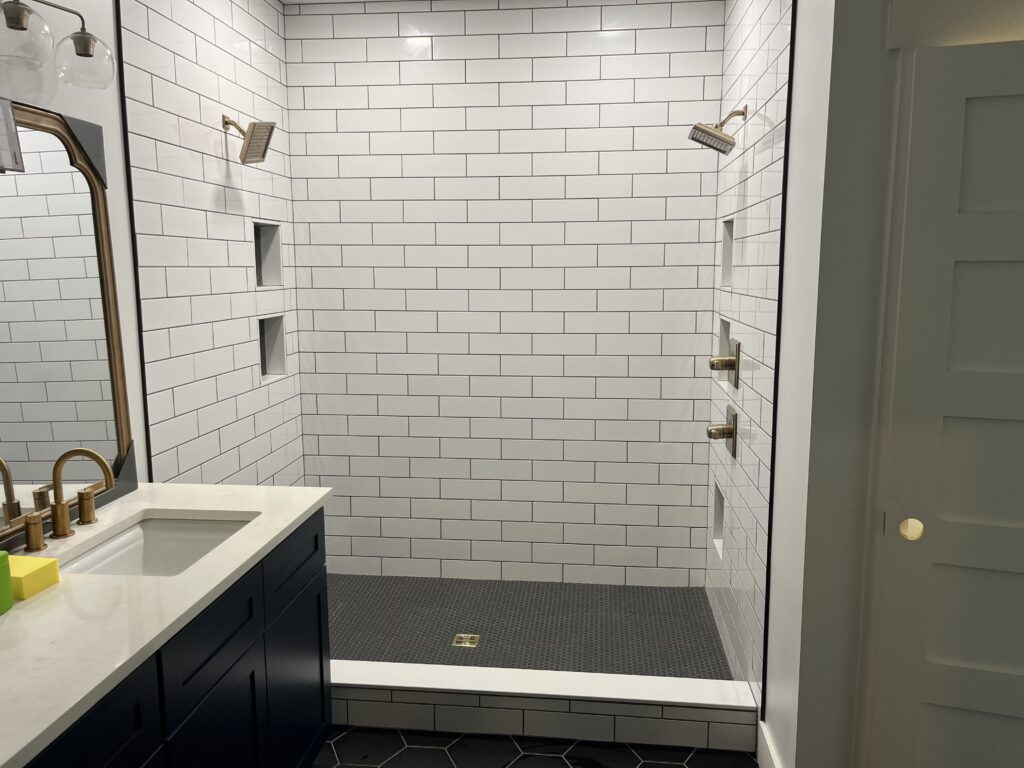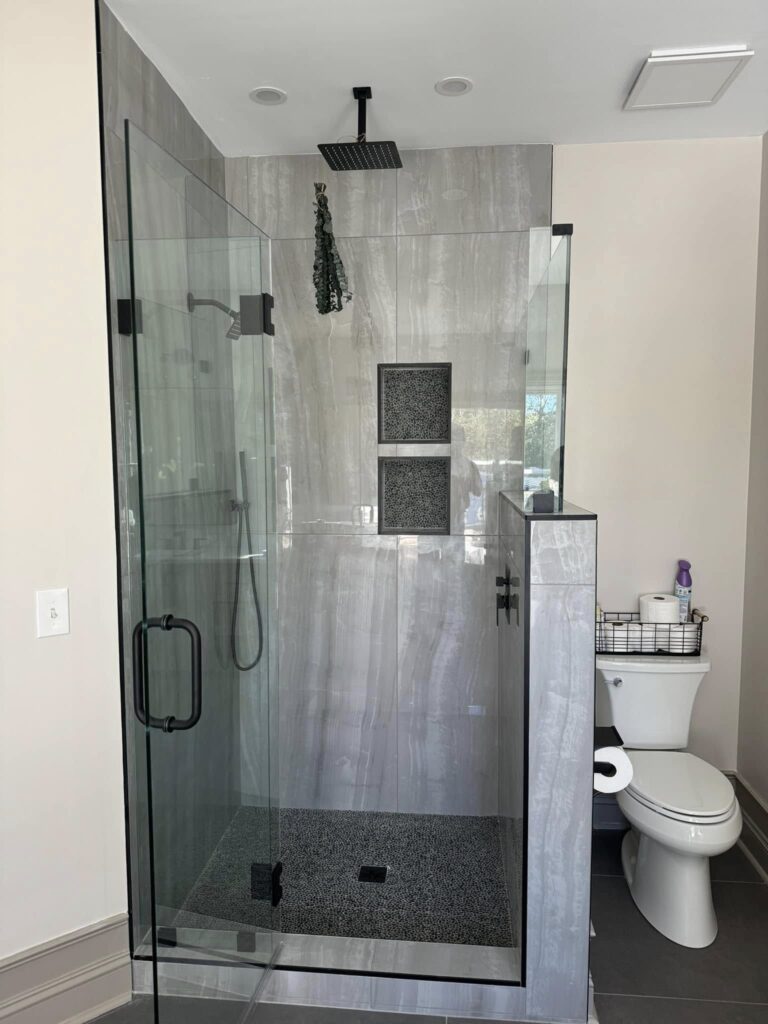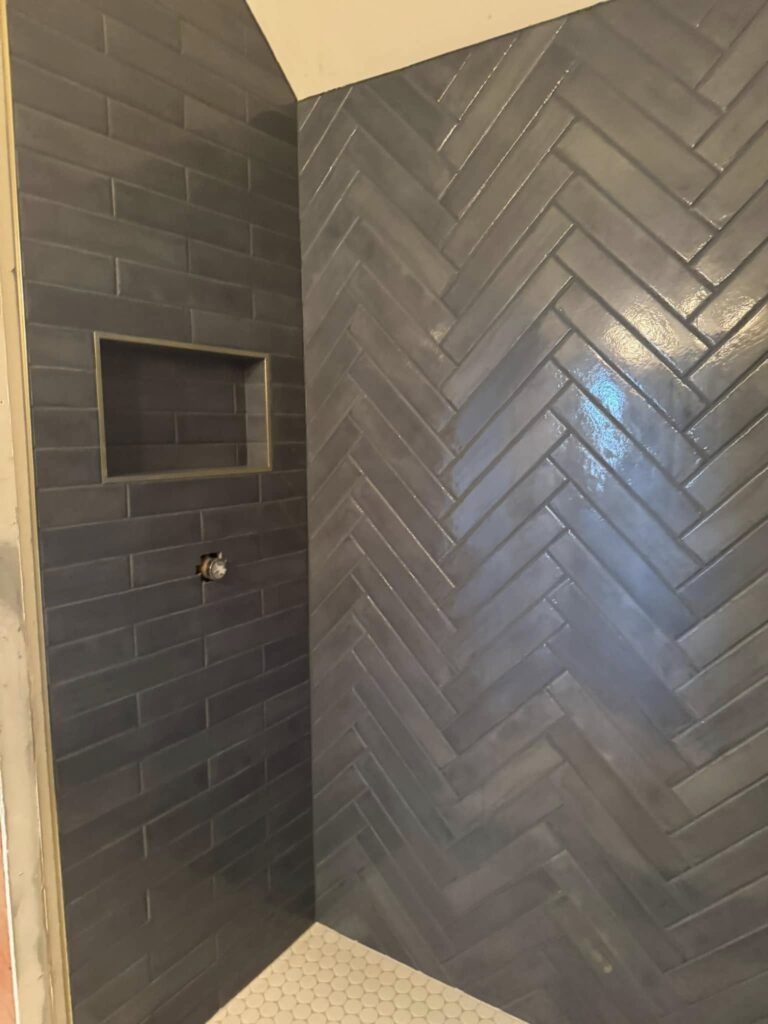Setting the Stage for Successful Small Bathroom Tile Selection
Let’s face it—small bathrooms present unique challenges when it comes to remodeling. As a shower remodel contractor, I’ve seen how proper tile selection can completely transform a small bathroom shower remodel from cramped and cluttered to spacious and stunning.
The tiles you choose can either make your small bathroom feel even more confined or create an illusion of openness that changes the entire feel of the space.
In my years working with homeowners, I’ve noticed that tile selection is often an afterthought. Yet it’s arguably the most crucial decision you’ll make during your renovation project. The right tiles don’t just look good—they functionally change how you experience your bathroom.
In this guide, I’ll share my professional insights on selecting the perfect tiles for small bathroom spaces. From colors and sizes to patterns and finishes, these tips will help you maximize every inch of your bathroom while creating a design you’ll love for years to come.
Why Tile Selection Makes or Breaks Your Small Bathroom Shower Remodel

When planning your shower remodeling project, your tile selection will have the biggest visual impact of any design choice you make. Tiles cover the largest surface area in your bathroom and immediately draw the eye upon entering the space. They set the tone for the entire room.
I’ve walked into countless small bathrooms that feel cramped and claustrophobic simply because of poor tile choices. Dark, busy patterns with thick grout lines visually chop up the space and make walls feel like they’re closing in. Conversely, I’ve transformed tiny bathrooms into spaces that feel surprisingly roomy through strategic tile selection.
Common Tile Mistakes in Small Bathrooms
The biggest mistake I see homeowners make is assuming small tiles work best in small spaces. This seems logical but actually creates the opposite effect. Small mosaic tiles mean more grout lines, which visually segment the space and make it feel busier and more confined.
Another common error is choosing high-contrast tiles that create visual boundaries. When your eye can clearly see where surfaces begin and end, it becomes much more aware of the room’s actual dimensions. This is why I often recommend more subtle transitions in small spaces.
Using overly dark colors is the third mistake I frequently encounter. While dark tiles can look sophisticated in large bathrooms, they tend to absorb light in small spaces, making them feel cave-like and smaller than they actually are.
The Power of Color: Which Tile Shades Maximize Small Shower Spaces
Color selection is perhaps the most powerful tool at your disposal when designing a small bathroom. During shower renovation, selecting the right color palette is something our shower renovation services always prioritize with clients because of its outsized impact.
Light colors are generally your best friends in small spaces. Whites, creams, light grays, and pale blues reflect light rather than absorb it, instantly making your bathroom feel airier. This doesn’t mean your bathroom has to be boring—you can create depth through subtle variations in tone rather than stark color contrasts.
The 60-30-10 Rule for Small Bathroom Color Schemes
In my professional practice, I often recommend following the 60-30-10 rule for balanced color distribution. This means:
- 60% of your tile should be your primary color (typically the lightest shade)
- 30% should be your secondary color (a complementary mid-tone)
- 10% should be your accent color (which can be bolder for visual interest)
This approach allows you to incorporate color without overwhelming the space. For shower remodeling projects in small bathrooms, I often suggest using the lightest color for most wall surfaces, the secondary color for floors or shower pans, and the accent color for niches or decorative bands.
How Does Tile Size Affect Your Small Bathroom’s Appearance?

Here’s a counterintuitive truth that surprises many of my clients: larger tiles typically make small spaces look bigger, not smaller. As a shower remodel company, we often recommend larger tiles for small spaces, contrary to what many expect. The reason is simple—fewer grout lines mean less visual interruption.
Large-format tiles create a smoother, more continuous surface that allows your eye to travel freely around the room. This creates an expanded sense of space rather than the chopped-up feeling that small tiles with numerous grout lines produce.
Optimal Tile Dimensions for Small Bathrooms
For shower walls in small bathrooms, I typically recommend tiles in the 12″×24″ range. These rectangular dimensions create a pleasing proportion while minimizing grout lines. For floors, 12″×12″ or larger works well, though I sometimes use slightly smaller tiles (around 8″×8″) on shower floors for better slip resistance and drainage.
If you love the look of small mosaic tiles, don’t worry—you can still incorporate them strategically. Consider using them in confined areas like shower niches or as subtle accent bands rather than covering entire walls. This gives you the visual interest without the space-reducing effect.
Smart Pattern Choices That Open Up Tight Bathroom Spaces

The direction and pattern of your tile layout dramatically impacts spatial perception. During bathroom shower remodel consultations, I always discuss pattern options that can visually expand the space. The right pattern creates an optical illusion that tricks the eye into seeing more space than actually exists.
Horizontal layouts, for instance, make walls appear wider, while vertical arrangements make ceilings seem higher. For particularly small bathrooms, I often recommend horizontal layouts on shorter walls to make them appear longer, creating better proportion in the room.
Pattern Strategies for Space Enhancement
Diagonal patterns like herringbone or chevron draw the eye along their longest lines, expanding the perceived dimensions of your space. These patterns create movement that extends beyond the actual tile edges, making the room feel larger than its physical boundaries.
For shower walls in tight spaces, I often suggest a simple staggered brick pattern using rectangular tiles. This classic pattern elongates walls while remaining timeless and visually clean. For those seeking more visual interest, an offset pattern with one-third overlap rather than the standard half overlap creates a more contemporary look without overwhelming small spaces.
5 Tile Finishes That Enhance Light and Space in Small Showers
The finish of your tile affects both how light moves through your bathroom and how spacious it feels. Our shower remodeling experts can help you select finishes that maximize your bathroom’s natural light. Here are the five finishes I recommend most often for small spaces:
1. Glossy Ceramic or Porcelain
High-gloss finishes act like mirrors, reflecting light around your bathroom. This reflection creates depth and brightness that can make walls recede visually. They’re also exceptionally easy to clean, making them practical for shower enclosures.
2. Satin or Semi-Gloss
These finishes provide moderate reflectivity without the sometimes harsh shine of fully glossy tiles. They strike a nice balance between light reflection and subtle sophistication. For homeowners concerned about slipping, satin finishes offer slightly better traction on floor surfaces.
3. Polished Stone-Look Porcelain
These tiles give you the elegant look of natural stone with the higher reflectivity and lower maintenance of porcelain. The subtle veining and movement in these tiles add dimension without creating busy patterns that can make spaces feel smaller.
4. Iridescent Glass
Small glass accent tiles with iridescent finishes create brilliant light play in shower niches or as decorative bands. They add a luxurious touch and depth while their reflective qualities enhance brightness. I always recommend using these strategically rather than for entire walls.
5. Lappato Finish
This “semi-polished” finish offers a subtle sheen that’s less reflective than full polish but more light-enhancing than matte options. It’s become increasingly popular for shower renovation services because it offers sophistication with practical slip resistance.
Are These Popular Small Bathroom Tile Trends Worth Following?
As a shower remodel contractor near me, I see which tile trends actually stand the test of time versus those that quickly feel dated. Some current trends work beautifully in small spaces, while others can make your bathroom feel cramped or busy.
Trends That Enhance Small Bathrooms
Large-format thin porcelain panels are one trend I can fully endorse for small bathrooms. These tiles can span entire walls with minimal grout lines, creating an expansive, seamless appearance that visually enlarges your space. The technology has improved dramatically, making these a practical option for shower remodels.
Tone-on-tone variations using the same color in different shades and finishes is another trend that works well in limited square footage. This approach adds depth and interest without creating stark contrasts that visually segment your space.
Trends to Approach Cautiously
Busy encaustic-style patterned tiles, while beautiful, can quickly overwhelm small bathrooms when used extensively. I recommend using these as a limited feature—perhaps on a single wall or as a “rug” inset on the floor—rather than throughout the entire space.
Similarly, high-contrast black and white combinations, though timeless in larger bathrooms, can make small spaces feel choppy and confined. If you love this classic look, consider a softer approach using charcoal and cream instead of stark black and white.
Practical Installation Tips That Maximize Your Small Bathroom’s Potential

The way your tiles are installed has almost as much impact as the tiles themselves. Our shower remodel services include installation techniques specifically designed for small spaces. These methods can dramatically change how spacious your bathroom feels.
Continuous floor-to-wall tiling creates a seamless transition that extends the eye’s path, making the space feel larger and more cohesive. Using the same tile on both surfaces eliminates the visual boundary between them, effectively expanding the perceived floor area.
Grout Considerations for Small Spaces
Grout line width significantly impacts spatial perception. In small bathrooms, I typically recommend narrow grout lines (1/16″ to 1/8″) in a color that closely matches your tile. This minimizes visual interruption and creates a more continuous surface that feels larger.
For ultimate space enhancement, consider epoxy grouts that can be applied in very thin lines and won’t discolor over time. Though slightly more expensive, they maintain their clean appearance much longer than traditional cement-based grouts, preserving that space-enhancing seamless look.
Strategic Niche Placement
Shower niches provide necessary storage without intruding into your shower space. For small bathrooms, I recommend recessing niches between wall studs to maintain a flush surface. Consider placing niches on interior shower walls rather than exterior ones to maintain structural integrity while providing convenient storage.
Tiling these niches with accent tiles creates a focal point that draws attention away from the room’s dimensions while adding personality. This is where you can incorporate those special tiles you love without overwhelming the entire space.
Creating Your Perfect Small Bathroom Tile Plan
When you’re ready to start your shower remodel, remember that thoughtful tile selection is your most powerful tool for transforming a small bathroom. The right tiles can make even the tightest spaces feel open, bright, and welcoming. By considering color, size, pattern, and finish, you can create a bathroom that feels spacious despite its actual dimensions.
Throughout this article, we’ve explored how strategic tile choices impact spatial perception and overall bathroom functionality. From using larger tiles with minimal grout lines to selecting light-reflecting finishes, these shower tile tips provide practical ways to maximize your small bathroom’s potential.
I encourage you to take these insights and apply them to your unique space. Consider your personal style preferences while keeping these spatial principles in mind. With the right approach, your small bathroom can become one of your home’s most impressive spaces.
Ready to transform your small bathroom with the perfect tile selection? Contact Elite Tile and Flooring today for a consultation to discuss how we can help select the perfect tiles for your small bathroom renovation. With our experience and your vision, we’ll create a space that feels both bigger and better than ever before.

